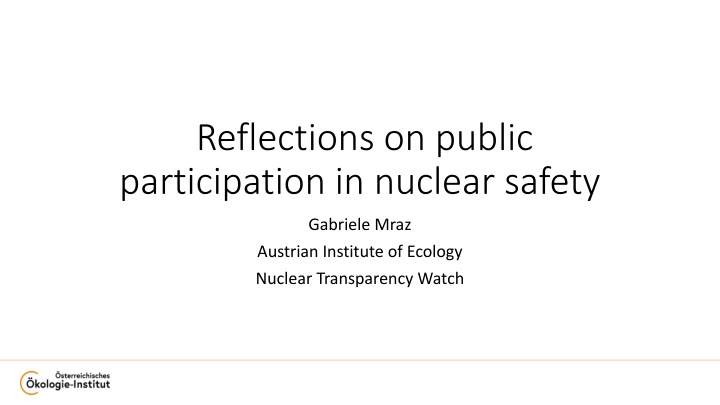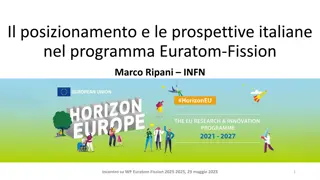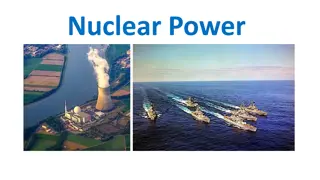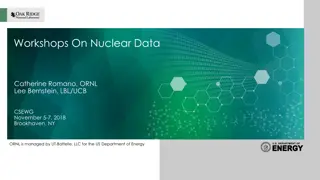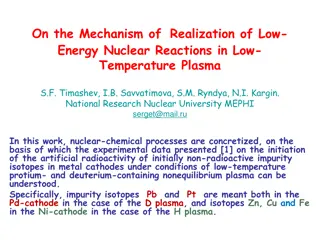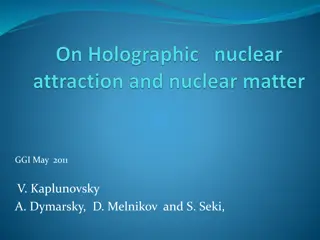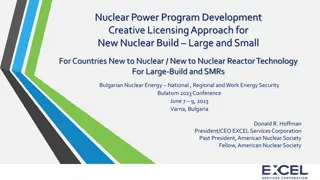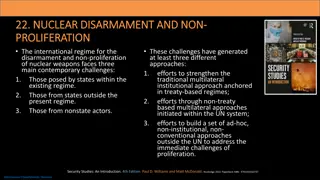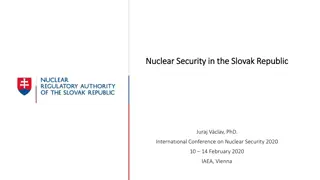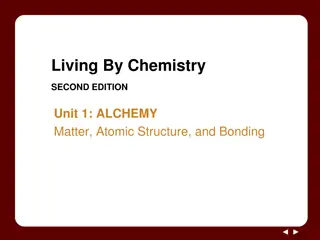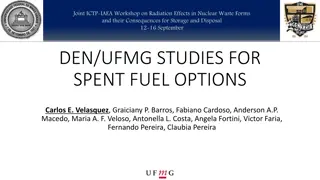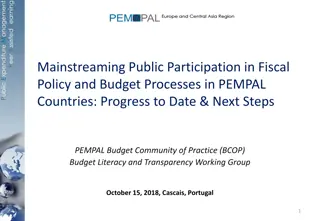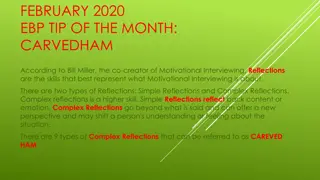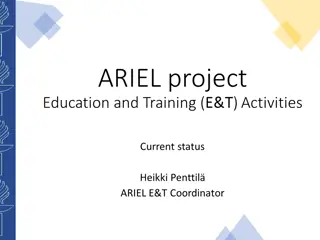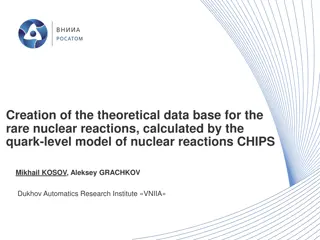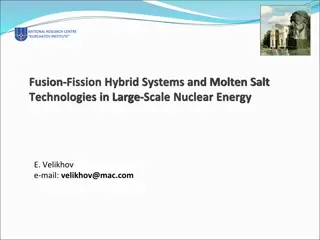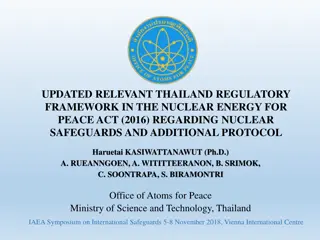Public Participation in Nuclear Safety Reflections
This document delves into the aspects of public participation in nuclear safety, exploring formal and content-related aspects, steps of licensing nuclear facilities, and the discourse on nuclear safety in public engagement. It discusses severe accidents, radiation protection measures, and differing approaches among countries in addressing nuclear safety concerns.
Download Presentation

Please find below an Image/Link to download the presentation.
The content on the website is provided AS IS for your information and personal use only. It may not be sold, licensed, or shared on other websites without obtaining consent from the author.If you encounter any issues during the download, it is possible that the publisher has removed the file from their server.
You are allowed to download the files provided on this website for personal or commercial use, subject to the condition that they are used lawfully. All files are the property of their respective owners.
The content on the website is provided AS IS for your information and personal use only. It may not be sold, licensed, or shared on other websites without obtaining consent from the author.
E N D
Presentation Transcript
Reflections on public participation in nuclear safety Gabriele Mraz Austrian Institute of Ecology Nuclear Transparency Watch
Overview Reflection on Art 8 (4) public participation in nuclear safety issues: Formal aspects: Participation in different steps of licensing Content-related aspects: What nuclear safety issues are discussed in participation procedures? What should be discussed? Conclusions My experience with participation in nuclear safety topics: Working with NGOs in European networks on nuclear topics and taking part in participation procedure Consulting Austrian authorities in participating in Strategic Environmental Assessments (SEA), Environmental Impact Assessments (EIA), and similar procedures
Steps of licensing of nuclear facilities Participation instruments foreseen for the general public, also transboundary Environmental license Environmental Impact Assessment (EIA) Site license If participation is possible, then often: Only on national level Only for selected parts of the public Only voluntary Without possibility of legal instruments Restricted content Or not at all Construction license Operation license Periodic Safety Reviews as condition for further operation Lifetime extension EIA since 2020 (Espoo Guidance on the applicability of the Convention to the lifetime extension of NPP) EIA Decommissioning license
Nuclear safety discussed in public participation Environmental assessment instruments are often the only chance for the public (also transboundary) to participate at all Therefore, it is necessary to analyse how nuclear safety is discussed there In the early step of the environmental license the reactor type often has not been selected, several sites can be in discussion Two examples: Severe accidents Nuclear security
Severe accidents between science and policy Countries have different approaches to discuss severe accidents in participation procedures Source terms for Cs-137 from EIA documents leading to different impact assessments: Hanhikivi: 100 TeraBecquerel (VVER 1200, project was cancelled) Paks II: 5.2 TeraBecquerel (VVER 1200) Countries have also different radiation protection measures and intervention levels What is safe enough in one country might not be safe enough in another one This is confusing and does not help to build trust which is needed in participation procedures on nuclear safety topics
Nuclear security Impacts of terrorism and war on nuclear safety need to be assessed And these assessments need to be discussed with the public In EIAs, this topic is often not adequately tackled or missing at all Especially old NPP were not designed to withstand a crash of a big airplane, plus there are new threats like attacks with drones This will also be of relevance when discussing deep geological repositories how to deal with intrusions
Nuclear safety in participation on life-time extension wanted: EIA Nuclear safety obligations were lower when old NPP were licensed For many old plants, no EIA has been made, therefore missing assessment of environmental impacts And no participation was possible What has changed since the first license? New scientific and technical knowledge, new threats, changes in the surroundings of the site ? Therefore, an EIA should be obligatory for each life-time extension. Despite the Espoo Guidance on EIA for LTE, many countries do not make an EIA (f.e. France made a participation on the generic phase for PSR4 with restricted technical questions, but no transboundary SEA or EIA)
Wanted: Participation in PSR, with risk report Public participation in each PSR needs to be established with adequate instruments If a NPP is safe or not safe is a decision on which risks are accepted. (see INRAG report on lifetime extension from 2021) It is not enough to get the information that a NPP is still safe . The public also should be informed how the risk changes over time. Such a risk report would need to present and assess all deviations of the old NPP from the recent state of science and technology, and be complementary to the safety report
The public needs independent expertise For most safety-relevant topics scientific and technical know-how is necessary to understand the critical points and to formulate the right questions For this, experts are needed whom the public trusts And for this the public need resources; and openness from regulators side: Example: Participation in the ENSREG topical peer reviews 1stTPR: Amongst others, NGOs asked for the involvement of independent experts in all steps who enjoy the trust of the NGOs, this was not granted 2ndTPR: We financed an expert by ourselves who supported us in commenting on the scope
Conclusions/1 The general public (incl. the transboundary public) does not have enough possibilities for effective participation on nuclear safety issues. Especially important would be to legally embed participation in all PSRs, and make (transboundary) EIA obligatory for all life-time extensions. Risk reports should be produced in addition to safety reports, to assess how the risk for accidents has changed due to ageing and the gap to safety obligations for new NPP etc.. Information on nuclear safety topics vary a lot between countries, f.e. very different source terms for severe accident scenarios even for the same reactor type a better approach would be helpful
Conclusions/2 Nuclear safety needs to be discussed very broadly in participation procedures, not only reduced on selected technical topics; all environmental impacts should be assessed in each life-time extension. Nuclear security needs to be put more into focus when discussion nuclear safety (terrorist attacks and war). Resources for independent expertise are needed to support the public in understanding and assessing nuclear safety information. Effective participation needs legally secured instruments, plus a broad variety of additional measures like consultations, regular dialogue and information. But it is not enough to invite the public for submitting statements without proper follow-up. Voluntary participation instruments cannot replace legally secured instruments.
Contact Gabriele Mraz Austrian Institute of Ecology mraz@ecology.at INRAG International Nuclear Risk Assessment Group: https://www.inrag.org/risks-of-lifetime-extension-of-old-nuclear- power-plants-download
